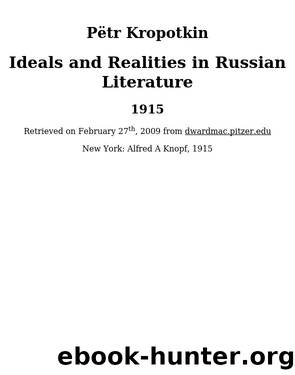Ideals and Realities in Russian Literature by Pëtr Kropotkin & Pëtr Kropotkin

Author:Pëtr Kropotkin & Pëtr Kropotkin
Language: eng
Format: epub
Tags: art, history
Published: 1915-08-14T16:00:00+00:00
The Precipice
At the time of the appearance of this novel âOblómoffdomâ became a current word to designate the state of Russia. All Russian life, all Russian history, bears traces of the malady â that laziness of mind and heart, that right to laziness proclaimed as a virtue, that conservatism and inertia, that contempt of feverish activity, which characterise Oblómoff and were so much cultivated in serfdom times, even amongst the best men in Russia â and even among the malcontents. âA sad result of serfdomâ â it was said then. But, as we live further away from serfdom times, we begin to realise that Oblómoff is not dead amongst us: that serfdom is not the only thing which creates this type of men, but that the very conditions of wealthy life, the routine of civilised life, contribute to maintain it.
âA racial feature, distinctive of the Russian race,â others said; and they were right, too, to a great extent. The absence of a love for struggle; the âlet me aloneâ attitude, the want of âaggressiveâ virtue; non-resistance and passive submission â these are to a great extent distinctive features of the Russian race. And this is probably why a Russian writer own work. As a result there is no wholeness, so to speak, in the main personages of the novel. The woman upon whom he has bestowed all his admiration, Vyéra, and whom he tries to represent as most sympathetic, is certainly interesting, but not sympathetic at all. One would say that Goncharóffâs mind was haunted by two women of two totally different types when he pictured his Vyéra â the one whom he tried â and failed â to picture in Sophie Byelovódova, and the other â the coming woman of the sixties, of whom he saw some features, and whom he admired, without fully understanding her. Vyéraâs cruelty towards her grandmother, and towards Ráisky, the hero, render her most unsympathetic, although you feel that the author quite adores her. As to the Nihilist, Vólokhoff, he is simply a caricature â taken perhaps from real life, â even seemingly from among the authorâs personal acquaintances, â but obviously drawn with the desire of ventilating personal feelings of dislike. One feels a personal drama concealed behind the pages of the novel. Goncharóffâs first sketch of Vólokhoff was, as he wrote himself, some sort of Bohemian Radical of the forties who had retained in full the Don Juanesque features of the âByronistsâ of the preceding generation. Gradually, however, Goncharóff, who had not yet finished his novel by the end of the fifties, transformed the figure into a Nihilist of the sixties â a revolutionist â and the result is that one has the sensation of the double origin of Vólokhoff, as one feels the double origin of Vyéra.
The only figure of the novel really true to life is the grandmother of Vyéra. This is an admirably painted figure of the simple, commonsense, independent woman of old Russia, while Martha, the sister of
Download
This site does not store any files on its server. We only index and link to content provided by other sites. Please contact the content providers to delete copyright contents if any and email us, we'll remove relevant links or contents immediately.
| Africa | Americas |
| Arctic & Antarctica | Asia |
| Australia & Oceania | Europe |
| Middle East | Russia |
| United States | World |
| Ancient Civilizations | Military |
| Historical Study & Educational Resources |
Rasputin by Joseph T. Fuhrmann(565)
Russian Revolution: A Concise History From Beginning to End (October Revolution, Russian Civil War, Nicholas II, Bolshevik, 1917. Lenin) (One Hour History Revolution Book 3) by Hourly History(338)
The Russian Revolution: A Very Short Introduction (Very Short Introductions) by S. A. Smith(336)
FROM RUSSIA, WITH LOVE by Ian Fleming(326)
Moscow Monumental by Katherine Zubovich(324)
The Russian Five by Keith Gave(314)
Reconstructing Lenin: An Intellectual Biography by Krausz Tamás(308)
Authoritarian Nightmare by John W. Dean & Bob Altemeyer(301)
Winter is Coming by Gary Kasparov(300)
Kremlin Rising by Peter Baker(275)
Io dirò la verità by Germano Maifreda(262)
Spetsnaz: The Inside Story of the Soviet Special Forces by Viktor Suvorov(246)
Voices From Stalingrad by Bastable Jonathan;(240)
My Further Disillusionment in Russia by Emma Goldman(239)
Russia Resurrected by Kathryn E. Stoner;(237)
13 KGB by Unknown(223)
The Russian Revolution in Ukraine (March 1917 â April 1918) by Nestor Makhno & Nestor Makhno(215)
Jihad and Death by Roy Olivier;(203)
Russian Revolution, 1917 (9781108109161) by Wade Rex A(190)
